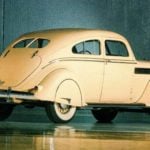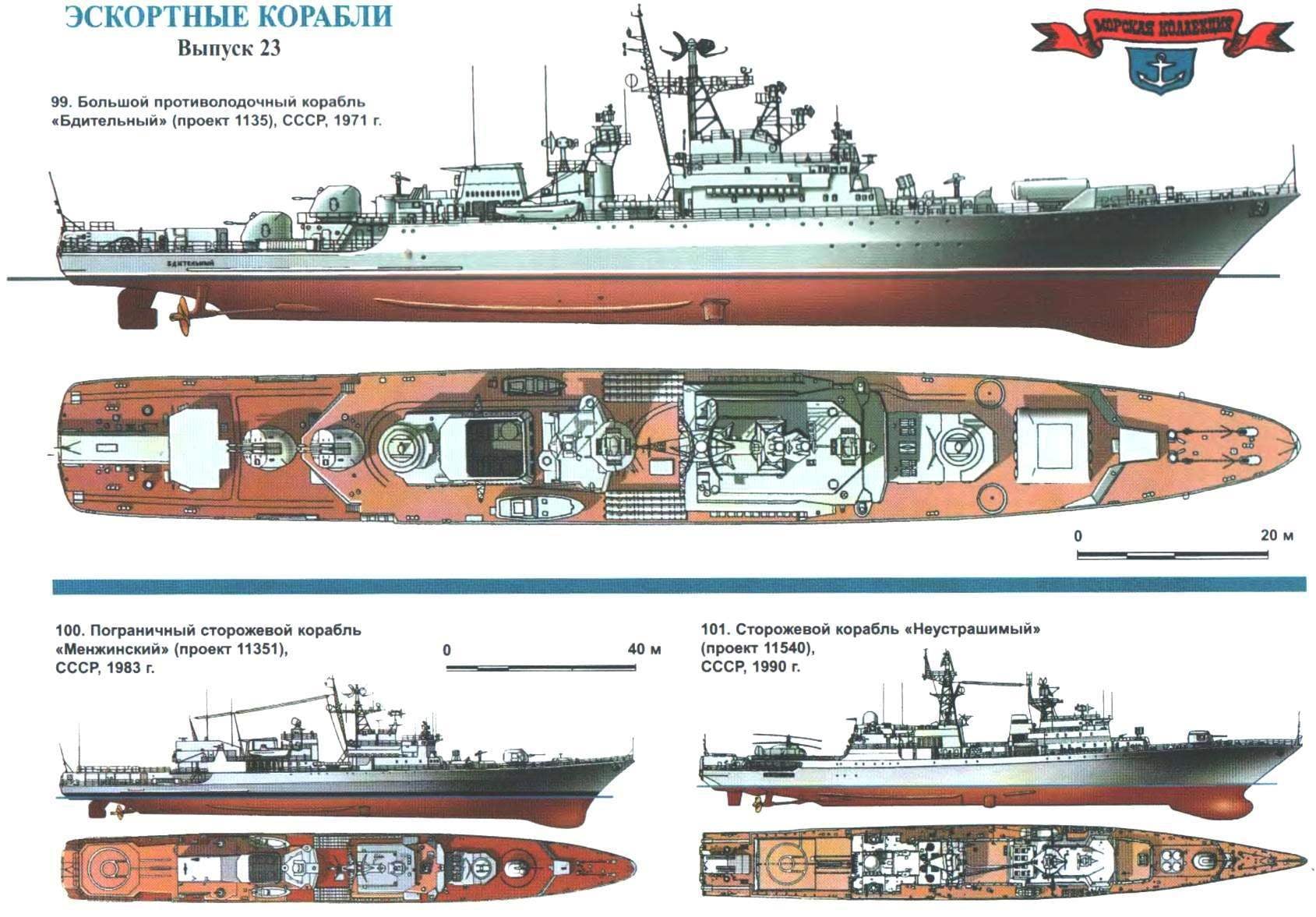 For several decades the Soviet patrol ships (TFR), formally considered as analogues of foreign frigates and corvettes, it was actually the destroyers — shock military units near the sea area. In fact, their successors and projects 35 159 focused on the fight against submarines, kept many of the “Menomonie” features: the same high speed, the same torpedo as the main weapon, the same “squat” silhouette with minimum add-ons… However, the emergence of the US nuclear submarines with ballistic missiles forced the Soviet Union to reconsider priorities.
For several decades the Soviet patrol ships (TFR), formally considered as analogues of foreign frigates and corvettes, it was actually the destroyers — shock military units near the sea area. In fact, their successors and projects 35 159 focused on the fight against submarines, kept many of the “Menomonie” features: the same high speed, the same torpedo as the main weapon, the same “squat” silhouette with minimum add-ons… However, the emergence of the US nuclear submarines with ballistic missiles forced the Soviet Union to reconsider priorities.
Now the Soviet Navy’s task was not to allow a potential enemy to their shores at a distance missile salvo. Accordingly, instead of flotillas of destroyers, there is a need in the larger ships of the PLO, are able to successfully combat enemy submarine on the ocean frontiers — not less than 3000 miles from their shores. Large anti-submarine ships (BOD) because of its small size to perform this task but could not. It was necessary to design a completely new ship is seaworthy enough for independent action in the ocean, but it is relatively inexpensive and suitable for large-scale buildings.
Terms of reference for the development of the TFR project 1135 (code name — “Thunderbird”) was issued in 1964. A new level of combat capability “Petrel” caused by the latest achievements of the domestic military-industrial complex — primarily racemoramide “Blizzard” and a very powerful hydroacoustic stations (GUS), podlinnoi “Titanium” towed “VEGA”. Fundamentally anti-complex “Snowstorm” was a development of the American system ASROCK, but had significantly better performance. Guided missile 85-P had a range of up to 50 km (ASROC about 10 km). As a warhead used a torpedo at-2U. She was dumped at a specified point on the parachute and hitting the water, moving in a spiral, gradually sinking deeper and deeper. The system is active homing all this time has been a continuous search for the submarine; as soon as the instrument has captured the target, the torpedo immediately went to her and increased the speed to 40 knots. Maximum range of the torpedo at-2U was 8 km.
In General, the appearance of ships of the project 1135 at the time was called (and not without reason!) breakthrough in the future. The new technology of buildings, wide use of non-traditional structural materials (titanium and fashionable aluminium-magnesium alloys), advanced automation system and electronic warfare are some of the applied in the project innovation. Very original was the power plant — two pairs of gas turbine, propulsion and afterburner working for the shafts through the gearboxes and tire-pneumatic clutch. All the mechanisms had a vibration damping coating and special shock absorbers. In addition, the acoustic field of the ship reduced system of underwater bubble masking. As a result, “eleven — thirty fifth” for its time, became the most low noise ships of the Soviet Navy.
The lead ship of the project 1135, named “Vigilant”, was laid down at Yantar shipyard in Kaliningrad in June 1968. December 31, (date, very characteristic of the era of the planned economy!) 1970 he officially went into operation, although the testing and commissioning of various systems continued for several months, including on the ground of Feodosia on the Black sea. By the way, during the transition around Europe, a new ship has attracted special attention of opponents in the “cold war”. The appearance “Alert” seemed to Western observers so impressive that the thought of his new missile cruiser, based on project 58 (“terrible”).
However, its characteristics parent “Petrel” in fact, strikingly different from its predecessors — TFR projects 50, 35 and 159. No wonder he at first attributed to the class of military-industrial complex. Only in 1977, the ships of project 1135 the newly reclassified in the TFR, which they appeared in the process of their development.
“Eleven — thirty fifth” series was built in three factories in Kaliningrad, Leningrad and Kerch— from 1968 to 1981. Only the composition of the Soviet Navy joined a 32 ship of this type, including 11 — with power artillery weapons (project 1135M). They were extremely successful ships, with high reliability of mechanisms, excellent seakeeping and maneuvering qualities. Important advantages include very powerful for their size weaponry and advanced electronics. It is noteworthy that served on the Thunderbirds sailors unanimously appreciate their extremely positive side.

102. The frigates “Talwar” (project 11356). India, 2003
Built in St. Petersburg at the Baltic shipyard. Displacement standard 3620 t full t 4035 maximum Length of 124.8 meters, width of 15.2 m, draft of 4.2 m. the average Power two-shaft gas turbine 48 000 HP, speed 30 knots. Armament: 8 vertical PU anti-ship missiles “Club-N” 1×1 PU SAM “Hurricane” (export designation “Shtil”), two anti-aircraft missile and artillery complex “Kortik” (export designation “Chestnut”), one 100-mm automatic gun mount, 2×2 anti-submarine torpedo tubes, one RBU-6000, one helicopter. Only in 2003 – 2004 built three units: the “Talwar”, “Triphon” and “Tabar”.

103. Patrol ship “Tatarstan” (project 11661), Russia, 2003
Built at the plant in Zelenodolsk. The standard displacement of 1500 tons, T. 1930 full Length the greatest to 102.2 m, beam of 13.1 m, draft of 3.5 m. average Power-shaft titelgestaltung installation 38 000 HP, speed 28 knots. Armament: 8 anti-ship missiles “Uranium”, 1×2 PU SAM “OSA-M”, one 100-mm automatic gun mount, two six-barreled 30-mm automatic, 2×2 anti-submarine torpedo tubes, one RBU-6000. All built two units: “Tatarstan” and “Dagestan”.
However, in the course of operation of ships of the project 1135 is revealed, and their drawbacks, chief among them is the disparity range anti-submarine missile complex “Storm” and sonar detection devices. No matter how perfect GUS was “Titan” and “VEGA”, they still usually able to establish reliable contact with a submarine of a potential enemy at a distance of 10-15 km, i.e. several times smaller than the range of racemoramide. This problem could be solved with a helicopter with the appropriate search equipment, but to place it on Board the ship without radical alterations were possible.
In the late 1980-ies attempted to enhance the combat capabilities of the “eleven — thirty fifth” due to the replacement of both GUS hydroacoustic complex of new generation “Zvezda-M1”. Along the way, he suggested that, instead of the radar “Angara-A” to install the latest station detection Fregat-MA” with a phased antenna array, instead of reactive mortars — two Quad launchers anti-ship missiles “Uranus” (Soviet equivalent of the American “Harpoon”). This improvement though does not solve all problems, but still significantly increased anti-submarine capabilities of the ships and also made them multi-purpose, able to deal with the surface by the enemy. However, the cost of the work was very high — for the installation of the “Stars” not only had to completely redo the underwater fairing, but also to lengthen the hull at 1.5 m (otherwise there was a risk of the hook fairing anchor). Moreover, with the beginning of “perestroika” financing of the fleet has decreased dramatically. As a result, a modernization program turned; to the collapse of the USSR managed to work only three ships, and that one of them (“Hot”), only partially, without replacement of the radar and the dismantling of the RBU.
A direct descendant of the “Petrel” was the border patrol ship “Menzhinsky” (project 11351, code name “Nereus”). He was commissioned by the KGB specifically for protection of extensive areas of the Pacific within the 200-mile economic zone of the USSR Special attention was paid to the seaworthiness of the ship, therefore, was taken as a prototype of the project 1135. Case and mechanisms remained unchanged, but the weapons and avionics have undergone substantial changes. From anti-complex “Snowstorm”, the second SAM “OSA-M” and one artillery of the main caliber decided to give up, but on the “Menzhinsky” had a hangar and landing pad for helicopter Ka-27, and two six-barreled 30 mm AK-630M. Hydroacoustic station “Titan” and “VEGA” were replaced by more compact systems, “Platinum” and “Bronze”. Displacement increased by 370 tonnes, but the price for the creation of a very versatile craft with well-balanced weapons is quite acceptable. Only in 1983 — 1990s for the far Eastern marine pogranchasti the KGB was built eight PSKR project 11351. Unfinished ninth after the collapse of the Soviet Union went to Ukraine in 1993, came into operation under the name “Hetman Sahaidachny”. Now he’s officially listed as a frigate and is the flagship of the Ukrainian Navy.
Curiously, the “Petrel” was originally designed as a specialized anti-submarine ship (this is quite consistent with the then current views), and with the emergence in the West of the frigates-wagon he in concept was immediately obsolete. But PSKR type menzhinskiy, who appeared as if a side line of development of the Soviet TFR, in fact, “get the point”; exactly as was seen in the early 1980s, multi-purpose ships of its class. It was logical to assume that a modified version of the project 11351 begin to build for the Navy. But, alas, this did not happen; the leadership of the Navy made a bid for a new project 11540. As shown by the subsequent course of events, the abandonment of further development of the successful “eleven — thirty fifth” was premature.

99. Large anti-submarine ship “Vigilant” (project 1135), USSR, 1971
Built in the Kaliningrad factory “amber”. Displacement standard 2835 t, full 3200 t Length overall 122,9 m, width 14.2 m, draught 4.5 m. the average Power two-shaft gas turbine 48 000 HP, speed 32 knots. Armament: 1×4 PU PLRK “Blizzard”, 2×2 PU SAM “OSA-M”, two twin 76-mm automatic artillery systems, 2×4 anti-submarine torpedo tubes, two RBU-6000. Only the 1970 — 1981 built 32 units, including 11 project 1135M (two single-barrel 100-mm gun mount is coupled 76-mm).
100. Border patrol ship “Menzhinsky” (project 11351), USSR, 1983
Built in the Kerch plant “Zaliv”. The standard displacement of 3180 tons, complete 3545 T. the Length of the longest 122,9 m, width 14.2 m, draught of 4.7 m. the average Power two-shaft gas turbine 56 000 HP, speed 32 knots. Armament: 1×2 PU SAM “OSA-M”, one 100-mm automatic gun mount, two six-barreled 30-mm automatic, 2×4 anti-submarine torpedo tubes, two RBU-6000, one helicopter Ka-27. Only 1983 — 1993 built nine units, including one for the Ukrainian Navy.
101. Patrol ship “fearless” (project 11540), USSR, 1990
Built in the Kaliningrad factory “amber”. Standard displacement is 3600 tons, full 4250 T. maximum Length 129,6 m, width 15.6 m, draft 4.6 m. the average Power two-shaft gas turbine 57 000 HP, a top speed of about 30 knots. Armament: 4 launchers SAM “Dagger”, 6×1 PLRK “Waterfall”, four anti-aircraft missile and artillery complex “Dirk”, one 100-mm automatic gun mount, one RBU-6000, one helicopter Ka-27. Only built one unit.
Patrol ship “fearless” (project 11540, code name “Hawk”) was created slowly and painfully. It was originally conceived as IPC with a displacement of about 800 tons (project 1154), but in the process of work the designers put all new and new challenges, and the ship, respectively, have steadily increased in size and “overgrown” different kinds of weapons. In the end, its displacement is greater than 4000 t — he became the major representative of the TFR in the domestic fleet. The rejection of unjustified savings enabled to produce a superstructure of steel (instead of aluminium alloy fire), and place on Board the most modern weapons — anti-aircraft missiles “Dagger”, anti-submarine recettore “Waterfall”, antiaircraft missile and artillery complexes “Dirk”, helicopter Ka-27… set of characteristics “fearless” is not inferior, and in some ways even superior to all their foreign “classmates”. A good (at least on paper) the project 11540, was selected for building mass — the command of the Navy has expressed the desire to have at least 70 such ships. True but all these plans were not destined.
The head of the TFR “fearless” and “Vigilant,” were built at the Yantar shipyard in Kaliningrad and was transferred to the fleet on the eve of 1991. The project was a “raw” — a system demanded operational development, in conditions of economic crisis is desperately short of funds. The case was compounded by the fact that Kaliningrad was cut off from Russia and each brought here few boundaries detail became insanely expensive. In the end, the completion of the second ship of the series, “Yaroslav the Wise”, was suspended, and the third, “Fog”, I had to disassemble the metal. So today in the ranks is the only ship of this type; another preserved in an unfinished form.
Numerous problems emerged in the process of testing “Fearless,” became the impetus for the development of an alternative version of the TFR. And then again recalled successful and well-developed in terms of technology “eleven — thirty fifth” — more precisely, on its boundary. Taking the General layout of the “Menzhinsky” and the case upgraded for the installation of SAS “Star-M1”, designers from North PKB re-designed add-ins (in accordance with the newfangled technology of “stealth”) and weapons placed close to existing on the “Fearless”. So the “stormy Petrel” there is another direct descendant of project 11356, satisfying the most exacting requirements for ships of the XXI century.
As to the order for building a new TFR for the Russian Navy failed, potential buyers had to look abroad. In November 1997, the contract for construction of three frigates of project 11356 was signed with India. In the export version of the other ships were equipped with sonar and had a slightly different armament. In particular, instead of SAM “Dagger” on them mounted missile system “Hurricane”, and instead of ASM “Uranus” special export “Club-N”. Frigates were named “Talwar” (“Sword”), “Trishul” (“Trident”) and “TA-bar” (“Axe”), they All were commissioned in 2003 — 2004, the Indian Navy became the owner of one of the most advanced surface ships in the world.
And the first patrol ship, which became part of the Russian Navy after a long, more than 20-year break, was small and much cheaper “Tatarstan” (project 11661, codename “Cheetah”). In fact, it was conceived as a purely export frigates, the successor to the once successful project 1159 (see “modelist-Konstruktor” No. 7 of 2004). The first two “Cheetah” was built at the factory in Zelenodolsk for the Iraqi Navy, but the sanctions imposed by the UN on the regime of Saddam Hussein, did the supply of ships to the customer impossible. About ten years stood they at the shipyard, until I finally decided to finish them for the Caspian flotilla. The acceptance report of the head of the “Tatarstan” was signed in June 2003 — almost simultaneously with the Indian “Talwara”. Of course, against the background of recent failed Iraqi frigate looks very modest, but in the Caspian sea (which is now out five independent States) it is still the largest and most powerful fighting unit. However, anti-submarine weapons “Tatarstan” and the same to him, “Dagestan” was unclaimed: submarines none of the Caspian countries is not in the foreseeable future is not expected.
S. BALAKIN
Recommend to read
 THE FIRST ATTEMPT
THE FIRST ATTEMPT
It is not easy to get out of the big banks pickled cucumber or tomato, but this fixture is not difficult. Take the Wire of Ø 3 mm stainless steel and prepare three items: U-shaped fork,... IN SPITE OF THE AIR FLOW
IN SPITE OF THE AIR FLOW
"Aerodynamic" Chrysler Airflow. Biography of Walter Chrysler of the typical American entrepreneur. Before creating his own company, he has worked as an assistant locomotive engineer, and...
 For several decades the Soviet patrol ships (TFR), formally considered as analogues of foreign frigates and corvettes, it was actually the destroyers — shock military units near the sea area. In fact, their successors and projects 35 159 focused on the fight against submarines, kept many of the “Menomonie” features: the same high speed, the same torpedo as the main weapon, the same “squat” silhouette with minimum add-ons… However, the emergence of the US nuclear submarines with ballistic missiles forced the Soviet Union to reconsider priorities.
For several decades the Soviet patrol ships (TFR), formally considered as analogues of foreign frigates and corvettes, it was actually the destroyers — shock military units near the sea area. In fact, their successors and projects 35 159 focused on the fight against submarines, kept many of the “Menomonie” features: the same high speed, the same torpedo as the main weapon, the same “squat” silhouette with minimum add-ons… However, the emergence of the US nuclear submarines with ballistic missiles forced the Soviet Union to reconsider priorities.





